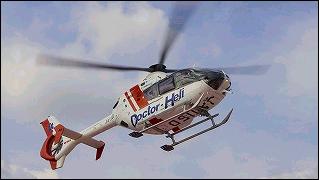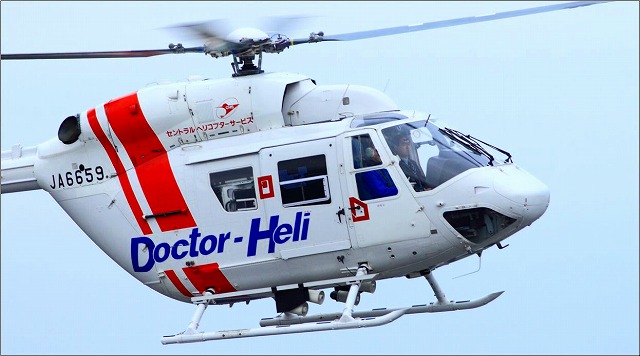<Straight Up>
HEMS in
Japan - Weak Today and Strong Future

The current progress of Japan's helicopter emergency system is running far behind those of advanced countries in Europe and the U.S.
Japan has not fallen behind those countries because we are ignorant of the medical benefits from helicopters emergency medical service. In fact, Japan had conducted experimental helicopter medical emergency service flights in 1981. And in 1994, the Japan Air Rescue Society was organized, whose core members include medical doctors, ambulance crews and commercial helicopter operators. Finally-20 years after the first helicopter medical emergency flights were conducted in 1981, the helicopter medical emergency system known as "Doctor-Helicopter" began service in 2001. And now after 7 years, 14 Helicopter Medical Emergency Service (HEMS) programs are in operation.
Japan is divided into 47 prefectures, including the metropolitan cities of Tokyo, Osaka and Kyoto. Therefore, about 50 HEMS programs are required in Japan if there is to be one program for each prefecture. Or, 80 programs are needed if Japan maintains the same level of service coverage that Germany has. Through this, we can see that the current 14 HEMS programs now in Japan are less than 30 percent of Japan's minimum requirements, and less than 20 percent of the ideal requirement, such as what Germany has.
It was very fortunate that a special law for promoting the spread of Doctor-Helicopter was legislated by the Diet last summer. It is necessary, however, to improve the current system of subsiding HEMS operations costs for promoting the spread of medical helicopter use. Both central and local governments presently bear half of these operations costs in prefectures that have programs in place, but this system is not sufficient for ongoing healthy operations. The new special law stipulates a way for alleviating the financial burden of local governments by collecting funds from the general public, in addition to social insurances, including health insurance and industrial accident insurance.
Neither funds from insurance nor the reduction of local government financial responsibility have been specifically determined, however, and the law stipulates that these responsibilities should be determined within three years from the date of the law's enactment. From this, we can see that the new law does not really promote expanding HEMS programs in Japan.
The past few years have seen an alarming decline in the number of emergency physicians in Japan, which has led to some hospitals closing their emergency departments, and, in turn, the contributing to the demise of emergency medical systems. HEMS is exactly the indispensable tool and solution to help supplement the shortage of medical care availability in Japan. Social awareness of HEMS has been rising, and the number of local regions that are interested in introducing Doctor-Helicopter has been increasing, which clearly demonstrates an interest and need for HEMS throughout Japan.
Three new HEMS programs, making at least 17 in total, are expected to start operations by March 31, 2009. In about three years, the number of programs will total 30. And in another five years, we should see 50 HEMS programs in operation. The approximate 5,000 patients currently saved in a year by Doctor-Helicopter will total more than 20,000 per year if there were 50 programs in operation. An estimated 2,000 patients would have already died without the Doctor-Helicopter service to save them-an appreciable number.
Japan should do its best in promoting the spread of HEMS for the good of the general population.
translated by Y.Yamano,
printed in Japan Aviation Weekly of May 26, 2008)
上の英文は、去る5月下旬チェコのプラハで開催された国際航空医療学会 AIRMED 2008 の事前抄録のために書いたもので、山野豊氏に英訳していただき、日本航空新聞社の週刊英字紙にも掲載された。念のために、もとの日本語メモは以下のとおりである。
ヘリコプター救急に関する日本の現状は、欧米の先進諸国にくらべて、大きく遅れをとっています。
ヘリコプター救急の医学的な有効性について、われわれが知らなかったわけではありません。事実、単発的な実験は1981年から何度も行なわれ、1994年には救急医師を中心として、消防救急隊員やヘリコプター運航者を含むエアレスキュー研究会が発足、普及のための運動を続けてきました。そして、ようやく2001年、最初の実験から20年目にして正式に「ドクターヘリ」と呼ばれるヘリコプター救急制度が発足しました。以来7年、今日ようやく全国14ヵ所で救急ヘリコプターが飛ぶようになりました。
日本には東京都や大阪府、京都府など、全国47の都道府県があります。したがってドクターヘリを各都道府県に1機ずつ配備すると、約50機の配備が必要で、これがドクターヘリの最小限の必要機数です。また国土面積から見てドイツなみの密度で配備すると80機が必要になります。したがって14機という現状は目標の3割以下であり、ドイツのような理想からすれば2割以下ということになります。
しかし昨年夏、ドクターヘリの普及を目的とする特別法が成立しました。普及のためには今の費用負担の方法を改める必要がある。現状は国と都道府県が半分ずつ負担しているけれども、それだけでは不充分。健康保険や労災保険などの社会保険からの給付を加え、一般国民からの寄付金も集めて、財政困難な自治体の負担分を軽減するといった方法を取ることにしたものです。
ただし具体的には、まだ保険給付額や自治体の負担軽減分などは決まってなく、今後3年以内に決めるという法律の内容ですから、今すぐドクターヘリが急増するわけではありません。
しかし近年、日本では救急医が不足し、救急部を閉鎖する病院が増えるなど、救急医療体制のほころびが出てきました。この医療過疎を補い、問題を解消できるのは、まさしくヘリコプターにほかなりません。したがって社会的にもヘリコプター救急に対する関心が高まり、ドクターヘリの導入を希望する地域が増えてきました。
今年度中には少なくとも3機増の17機になるはずですが、おそらく今後3年ほどの間に2倍の30機に達し、10年後には目標とする50機くらいのドクターヘリが飛ぶようになるものと思います。これによって救われる患者さんの数は、今の年間5,000人が2万人を超えることになるでしょう。その結果ヘリコプターがなければ死んだかもしれない患者さん、すなわち Preventable Death を免れる人は推定2,000人に達するもと思われます。
日本は、これから強力なヘリコプター救急体制をめざして、普及促進に努めることとなるでしょう。

